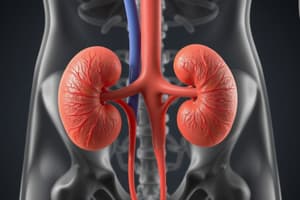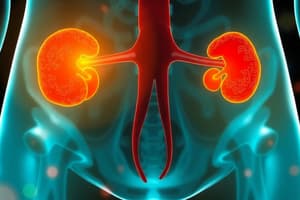Podcast
Questions and Answers
What is one of the primary functions of the urinary system?
What is one of the primary functions of the urinary system?
- Blood filtration (correct)
- Production of bile
- Regulation of body temperature
- Storage of dietary substances
Where are the kidneys located in relation to the columna vertebralis?
Where are the kidneys located in relation to the columna vertebralis?
- In the upper part of the posterior abdominal wall (correct)
- In the lower part of the abdominal cavity
- In front of the columna vertebralis
- Near the pelvic region
What is the structure through which blood vessels, nerves, and other items enter and exit the kidney?
What is the structure through which blood vessels, nerves, and other items enter and exit the kidney?
- Medulla renalis
- Cortex renalis
- Sinus renalis
- Hilum renale (correct)
Which part of the kidney contains the glomeruli and Bowman's capsules?
Which part of the kidney contains the glomeruli and Bowman's capsules?
What is the estimated rate of filtration occurring in the kidneys?
What is the estimated rate of filtration occurring in the kidneys?
How many nephrons are contained in each kidney?
How many nephrons are contained in each kidney?
What are the pyramidal structures found in the medulla of the kidneys called?
What are the pyramidal structures found in the medulla of the kidneys called?
What is the main role of the ureters in the urinary system?
What is the main role of the ureters in the urinary system?
What is the primary function of the bladder?
What is the primary function of the bladder?
Which part of the bladder contains the triangular area known as the trigonum vesicae?
Which part of the bladder contains the triangular area known as the trigonum vesicae?
How long is the urethra in females compared to males?
How long is the urethra in females compared to males?
Where do the ureters enter the pelvis?
Where do the ureters enter the pelvis?
What structure drains into the vena cava inferior?
What structure drains into the vena cava inferior?
Which statement about the bladder's capacity is correct?
Which statement about the bladder's capacity is correct?
What is the narrowest part of the bladder called?
What is the narrowest part of the bladder called?
Which type of artery does NOT participate in renal blood supply?
Which type of artery does NOT participate in renal blood supply?
Flashcards
Blood Filtration
Blood Filtration
The process of separating waste products and excess water from the blood, forming urine.
Nephrons
Nephrons
The functional units of the kidneys responsible for filtering blood and producing urine.
Renal Cortex
Renal Cortex
The outer layer of the kidney, containing structures like glomeruli and Bowman's capsules.
Renal Medulla
Renal Medulla
Signup and view all the flashcards
Renal Pelvis
Renal Pelvis
Signup and view all the flashcards
Filtration
Filtration
Signup and view all the flashcards
Ureter
Ureter
Signup and view all the flashcards
Urinary Bladder
Urinary Bladder
Signup and view all the flashcards
Excretion in the Nephron
Excretion in the Nephron
Signup and view all the flashcards
Reabsorption in the Nephron
Reabsorption in the Nephron
Signup and view all the flashcards
Renal Artery
Renal Artery
Signup and view all the flashcards
Bladder
Bladder
Signup and view all the flashcards
Cervix Vesicae
Cervix Vesicae
Signup and view all the flashcards
Pars Prostatica
Pars Prostatica
Signup and view all the flashcards
Study Notes
Urinary System Overview
- The urinary system's function is to filter blood and eliminate waste.
- It comprises six major organs: two kidneys, two ureters, the urinary bladder, and the urethra.
Kidneys
- Located in the posterior abdominal wall, on either side of the vertebral column.
- The right kidney is positioned at the level of T12 to L3, and the left kidney at the level of T11 to L2.
- The left kidney is slightly higher than the right.
- Kidneys filter blood and excrete waste products (forming urine).
- Kidneys maintain blood volume and pressure, electrolytes, and acid-base balance.
Ureters
- The ureters transport urine from the kidneys to the bladder.
- Approximately 25-30 cm long.
- Ureters pass through the linea terminalis, entering the pelvis minor.
- Ureters travel along the pelvis's lateral wall to reach the bladder.
Bladder
- Functions as a urine reservoir.
- Located posterior to the symphysis pubis (anterior to the uterus in females and anterior to the rectum in males).
- Normal capacity is ~220 mL, but can hold up to 500 mL.
- An empty bladder lies within the pelvis minor; a full bladder extends to the level of the umbilicus.
Urethra
- Transports urine from the bladder to the outside of the body.
- In males, it is ~20 cm long, while in females, it's ~3-5 cm long.
- Urethra has internal and external sphincter muscles to control urine flow.
Urinary System Component Details
- Calyx minor: Urine-collecting structures.
- Calyx major: Structures that collect urine from minor calyxes.
- Renal pelvis: Urine-collecting funnel within the kidney.
- Urinary bladder: Hollow muscular organ storing urine.
- Ureters: Urine-transporting tubes.
- Urethra: Urine-expelling tube.
- Renal artery: Supplies blood to the kidneys.
- Renal vein: Drains blood from the kidneys.
- Afferent arteriole: Carries blood to the glomerulus.
- Efferent arteriole: Carries blood away from the glomerulus.
- Glomerulus: Network of capillaries within the nephron, where filtration occurs.
- Nephron: Basic functional unit of the kidney.
- Glomerular capsule (Bowman's capsule): Cup-shaped structure surrounding the glomerulus.
- Loop of Henle: Part of the nephron, crucial for water reabsorption.
- Collecting duct: Receives urine from nephrons.
Additional Information
- Women are more prone to urinary tract infections as the urethra is shorter and closer to the anus.
- Males have a longer urethra, offering less frequency of urinary infections.
- Kidneys are responsible for regulating blood pressure.
- Kidneys play a role in blood volume and electrolyte control.
Studying That Suits You
Use AI to generate personalized quizzes and flashcards to suit your learning preferences.




